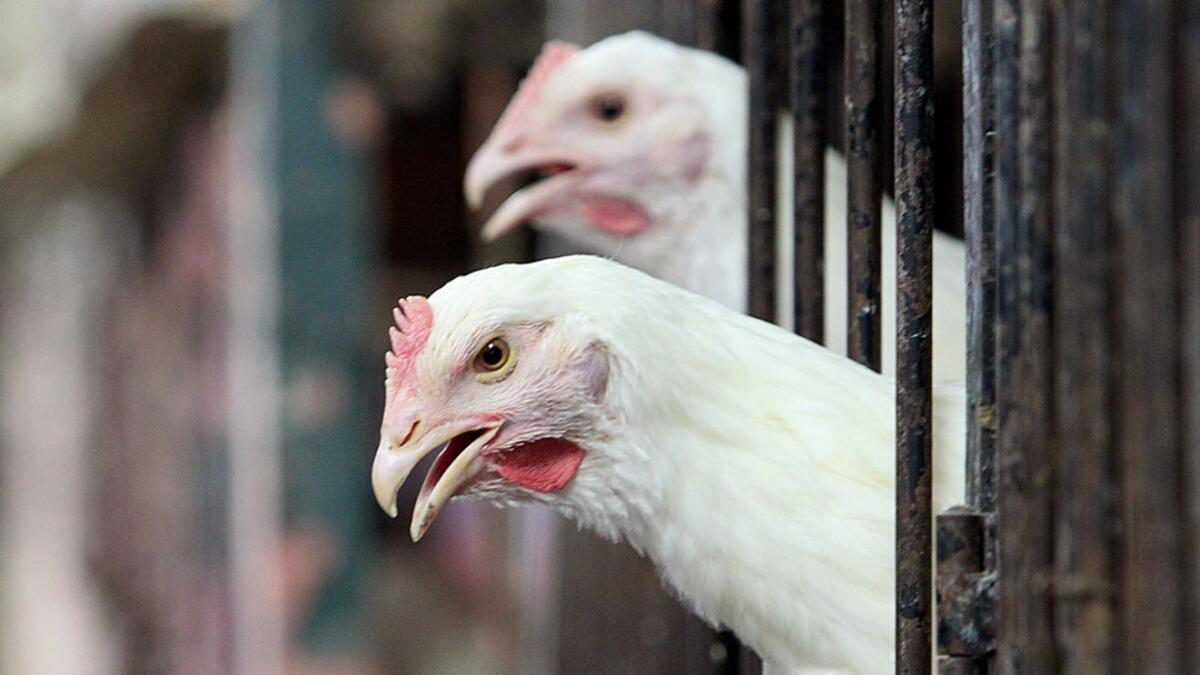Chicken industry pushes against movement that wants svelter, slower-growing birds

The chicken industry pushed back Wednesday against a growing campaign to move away from breeding larger birds that bulk up quickly, saying the “slow-growth” movement would use more energy, cost shoppers more and possibly result in less protein on people’s plates.
If even a third of the nation’s $48-billion poultry industry switched to more svelte chickens, the national flock would need to grow by 1.5 million birds to keep up with current consumption rates, according to an economic analysis released Wednesday by the National Chicken Council, a not-for-profit trade association.
That increase would require an additional 5.1 billion gallons of water and 7.6 million acres of land to raise the additional feed those chickens would need, according to the report.
“It comes with trade-offs, and that’s what we want to get out there,” said Tom Super, spokesman for the council. “Before it becomes a domino issue like the cage-free eggs, we want our customers to have all of the information on hand while they’re making these decisions.”
The report, prepared by an industry consulting group, comes after a year marked by increased pressure from consumers, retailers and food service companies to transform practices at the nation’s factory farms, including the use of antibiotics, housing chickens in crowded cages and failing to stun birds properly before slaughter.
Last March, Whole Foods Market announced it would require its suppliers to switch back to slower-maturing breeds and to improve farm conditions by 2024 as part of the Global Animal Partnership program the retailer created to push for more humane treatment of farm animals. In November, food service titans Aramark and Compass Group agreed to follow the same standards.
“It is really unsustainable to have business practices that cause so much suffering, are so unhealthy, that consumers are appalled and reject the product when they’re educated about what’s happening,” said Daisy Freund, director of farm animal welfare for the American Society for the Prevention of Cruelty to Animals, which has pushed the slow-growth movement.
In the 1920s, the average U.S. domesticated chicken was a relatively scrawny bird — weighing a mere 2½ pounds at slaughter, some 115 days after it was born. It now averages about 6 pounds and takes only 49 days to reach “market maturity,” according to the council.
Most of that transformation has occurred since 1965, when Americans ate 28 pounds of chicken apiece annually, according to the U.S. Department of Agriculture. Just since 1990, the average broiler has put on two pounds, Super said, and Americans now eat about 91 pounds of chicken each every year, according to the USDA.
Part of that growth spurt came from routinely feeding animals small doses of antibiotics that change their gut microbiome, improving immunity and enhancing their metabolism. But most of the growth came from simple animal husbandry advances.
“The practices that lead to bigger chickens are genetics and breeding,” Super said. “If we wanted to make the chickens into basketball players we would find the Lebron James roosters and the Lisa Leslies of hens and we’d get them together. That’s kind of in a nutshell what breeders do.”
Studies have suggested that the most common breed in the poultry food chain, the Cornish Cross, has become “an extreme organism” that can’t support its own weight.
“This is causing lameness, broken bones, heart attacks,” the ASPCA’s Freund said. “Birds are obese, and they’re constantly lying in their own waste. That causes open sores on their breasts and feet, and those can be conduits for bacteria. And of course, all of this requires the use of antibiotics to prop up this unsustainable system.”
Although most of the antibiotics and other drugs used on factory farms don’t have human uses, several are considered medically important to combat human illnesses. Misuse of antibiotics in human and veterinary medicine has led to the proliferation of antibiotic-resistant “superbugs” that cause at least 23,000 human deaths annually in the U.S., according to the Centers for Disease Control and Prevention.
In the past two years, McDonald’s, Subway, Panera Bread and Chipotle Mexican Grill have implemented policies to eliminate medically important antibiotics in their supply chain.
The U.S. Food and Drug Administration recently expanded its voluntary program to limit antibiotic use to remedies “considered necessary for assuring animal health” under “veterinary oversight or consultation.”
Activists say the European Union’s more aggressive conversion to leaner poultry breeds has halved flock mortality rates and resulted in a sixfold decrease in use of antibiotics.
The National Chicken Council disputes those studies, saying they don’t make comparisons relevant to U.S. flocks.
“We don’t know for sure as to whether the birds would be more susceptible or resistant to disease,” said Ashley Peterson, vice president for regulatory affairs for the council.
The council called for more U.S.-based research into whether reversing decades of animal husbandry would improve the welfare of chickens.
“We know that it’s bad for the environment; we know that it’s bad for economic reasons and we know that it’s bad for sustainability,” Super said. “But do we know that it’s better for the welfare of the chicken? We don’t, and we want to find the answer to that question.”
Follow me: @LATgeoffmohan
ALSO
American Apparel is sold at auction to Canada’s Gildan Activewear
Snapchat maker Snap dodges uproar — and maybe taxes — with London office
Frank Gehry’s $1-billion downtown project could finally be a go after infusion of Chinese capital







